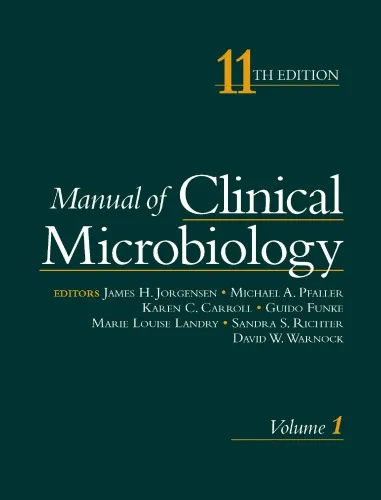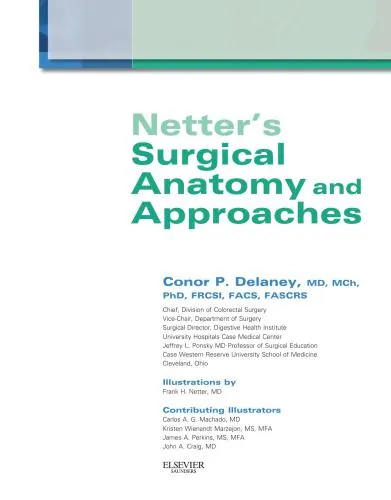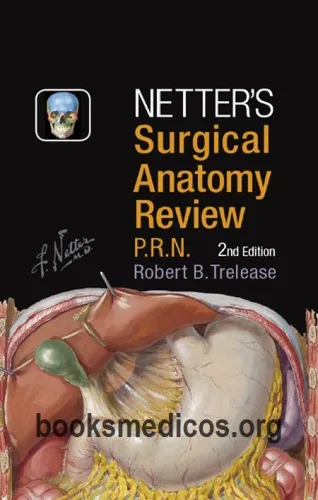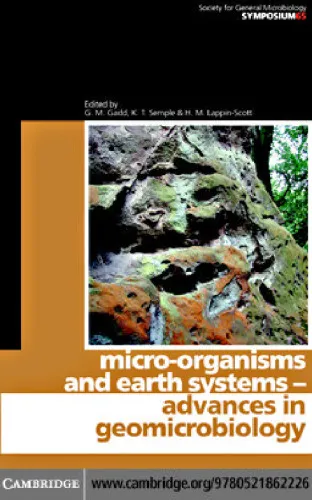Reference ASM Press
4.8
Reviews from our users

You Can Ask your questions from this book's AI after Login
Each download or ask from book AI costs 2 points. To earn more free points, please visit the Points Guide Page and complete some valuable actions.Related Refrences:
Yersinia -- Aeromonas -- Vibrio and Related Organisms -- Pseudomonas -- Burkholderia, Stenotrophomonas, Ralstonia, Cupriavidus, Pandoraea, Brevundimonas, Comamonas, Delftia, and Acidovorax -- Acinetobacter, Chryseobacterium, Moraxella, and Other Nonfermentative Gram-Negative Rods -- Bordetella and Related Genera -- Francisella -- Brucella -- Bartonella -- Legionella -- Approaches to Identification of Anaerobic Bacteria -- Peptostreptococcus, Finegoldia, Anaerococcus, Peptoniphilus, Veillonella, and Other Anaerobic Cocci -- Propionibacterium, Lactobacillus, Actinomyces, and Other Non-Spore-Forming Anaerobic Gram-Positive Rods -- Clostridium -- Bacteroides, Porphyromonas, Prevotella, Fusobacterium, and Other Anaerobic Gram-Negative Rods -- Algorithms for Identification of Curved and Spiral-Shaped Gram-Negative Rods -- Campylobacter and Arcobacter -- Helicobacter -- Leptospira -- Borrelia -- Treponema and Brachyspira, Human Host-Associated Spirochetes -- General Approaches to Identification[...]of Mycoplasma, Ureaplasma, and Obligate Intracellular Bacteria -- Mycoplasma and Ureaplasma -- Chlamydiaceae -- Rickettsia and Orientia -- Ehrlichia, Anaplasma, and Related Intracellular Bacteria -- Coxiella -- Tropheryma whipplei -- Antibacterial Agents -- Mechanisms of Resistance to Antibacterial Agents -- Susceptibility Test Methods: General Considerations -- Susceptibility Test Methods: Dilution and Disk Diffusion Methods -- Antimicrobial Susceptibility Testing Systems -- Special Phenotypic Methods for Detecting Antibacterial Resistance -- Susceptibility Test Methods: Fastidious Bacteria -- Susceptibility Test Methods: Anaerobic Bacteria -- Susceptibility Test Methods: Mycobacteria, Nocardia, and Other Actinomycetes -- Molecular Detection of Antibacterial Drug Resistance.;"The Gold Standard for medical microbiology, diagnostic microbiology, clinical microbiology, infectious diseases due to bacteria, viruses, fungi, parasites; laboratory and diagnostic techniques, sampling and testing, new diagnostic techniques and tools, molecular biology; antibiotics/ antivirals/ antifungals, drug resistance; individual organisms (bacteria, viruses, fungi, parasites)"--Publisher's description;v. 2: Taxonomy and Classification of Viruses -- Specimen Collection, Transport, and Processing: Virology -- Reagents, Stains, Media, and Cell Cultures: Virology -- Algorithms for Detection and Identification of Viruses -- Human Immunodeficiency Viruses -- Human T-Cell Lymphotropic Viruses -- Influenza Viruses -- Parainfluenza and Mumps Viruses -- Respiratory Syncytial Virus and Human Metapneumovirus -- Measles and Rubella Viruses -- Enteroviruses and Parechoviruses -- Rhinoviruses -- Coronaviruses -- Hepatitis A and E Viruses -- Hepatitis C Virus -- Gastroenteritis Viruses -- Rabies Virus -- Arboviruses -- Hantaviruses -- Arenaviruses and Filoviruses -- Herpes Simplex Viruses and Herpes B Virus -- Varicella-Zoster Virus -- Human Cytomegalovirus -- Epstein-Barr Virus -- Human Herpesviruses -- Adenoviruses -- Human Papillomaviruses -- Human Polyomaviruses -- Parvovirus B19 and Bocaviruses -- Poxviruses -- Hepatitis B and D Viruses -- Transmissible Spongiform Encephalopathies -- Antiviral Agents -- Mechanisms of Resistance to Antiviral Agents -- Susceptibility Test Methods: Viruses -- Taxonomy and Classification of Fungi -- Specimen Collection, Transport, and Processing: Mycology -- Reagents, Stains, and Media: Mycology;General Approaches for Direct Detection and Identification of Fungi -- Candida, Cryptococcus, and Other Yeasts of Medical Importance -- Pneumocystis -- Aspergillus and Penicillium -- Fusarium and Other Opportunistic Hyaline Fungi -- Agents of Systemic and Subcutaneous Mucormycosis and Entomophthoromycosis -- Histoplasma, Blastomyces, Coccidioides, and Other Dimorphic Fungi Causing Systemic Mycoses -- Trichophyton, Microsporum, Epidermophyton, and Agents of Superficial Mycoses -- Curvularia, Exophiala, Scedosporium, Sporothrix, and Other Melanized Fungi -- Fungi Causing Eumycotic Mycetoma -- Mycotoxins -- Lacazia, Lagenidium, Pythium, and Rhinosporidium -- Microsporidia -- Antifungal Agents -- Mechanisms of Resistance to Antifungal Agents -- Susceptibility Test Methods: Yeasts and Filamentous Fungi -- Taxonomy and Classification of Human Parasitic Protozoa and Helminths -- Specimen Collection, Transport, and Processing: Parasitology -- Reagents, Stains, and Media: Parasitology -- General Approaches for Detection and Identification of Parasites -- Plasmodium and Babesia -- Leishmania and Trypanosoma -- Toxoplasma -- Pathogenic and Opportunistic Free-Living Amebae -- Intestinal and Urogenital Amebae, Flagellates, and Ciliates -- Cystoisospora, Cyclospora, and Sarcocystis -- Cryptosporidium -- Nematodes -- Filarial Nematodes -- Cestodes -- Trematodes -- Less Common Helminths -- Arthropods of Medical Importance -- Antiparasitic Agents -- Mechanisms of Resistance to Antiparasitic Agents -- Susceptibility Test Methods: Parasites.;v. 1: Introduction to the 11th Edition of the Manual of Clinical Microbiology -- Microscopy -- Laboratory Detection of Bacteremia and Fungemia -- Systems for Identification of Bacteria and Fungi -- Automation and Design of the Clinical Microbiology Laboratory -- Molecular Microbiology -- Immunoassays for Diagnosis of Infectious Diseases -- Prevention of Health Care-Associated Infections -- Investigation of Disease Outbreaks -- Molecular Epidemiology -- Procedures for the Storage of Microorganisms -- Prevention of Laboratory-Acquired Infections -- Decontamination, Disinfection, and Sterilization -- Biothreat Agents -- The Human Microbiome -- Microbial Genomics and Pathogen Discovery -- Taxonomy and Classification of Bacteria -- Specimen Collection, Transport, and Processing: Bacteriology -- Reagents, Stains, and Media: Bacteriology -- General Approaches to Identification of Aerobic Gram-Positive Cocci -- Staphylococcus, Micrococcus, and Other Catalase-Positive Cocci -- Streptococcus -- Enterococcus -- Aerococcus, Abiotrophia, and Other Aerobic Catalase-Negative, Gram-Positive Cocci -- General Approaches to the Identification of Aerobic Gram-Positive Rods -- Bacillus and Other Aerobic Endospore-Forming Bacteria -- Listeria and Erysipelothrix -- Coryneform Gram-Positive Rods -- Nocardia, Rhodococcus, Gordonia, Actinomadura, Streptomyces, and Other Aerobic Actinomycetes -- Mycobacterium: General Characteristics, Laboratory Detection, and Staining Procedures -- Mycobacterium: Laboratory Characteristics of Slowly Growing Mycobacteria -- Mycobacterium: Clinical and Laboratory Characteristics of Rapidly Growing Mycobacteria -- Approaches to the Identification of Aerobic Gram-Negative Bacteria -- Neisseria -- Aggregatibacter, Capnocytophaga, Eikenella, Kingella, Pasteurella, and Other Fastidious or Rarely Encountered Gram-Negative Rods -- Haemophilus -- Escherichia, Shigella, and Salmonella -- Klebsiella, Enterobacter, Citrobacter, Cronobacter, Serratia, Plesiomonas, and Other Enterobacteriaceae
Free Direct Download
You Can Download this book after Login
Accessing books through legal platforms and public libraries not only supports the rights of authors and publishers but also contributes to the sustainability of reading culture. Before downloading, please take a moment to consider these options.
Find this book on other platforms:
WorldCat helps you find books in libraries worldwide.
See ratings, reviews, and discussions on Goodreads.
Find and buy rare or used books on AbeBooks.
1085
بازدید4.8
امتیاز0
نظر98%
رضایتReviews:
4.8
Based on 0 users review
Questions & Answers
Ask questions about this book or help others by answering
Please login to ask a question
No questions yet. Be the first to ask!








